The question of “How to cook a steak?” has as many answers as steak eaters. There are so many ways to get to a very good steak. Some methods are very tough to replicate in a home kitchen and some methods (like sous-vide steak) require a lot of time and fancy equipment. But, most home cooks can make a very delicious steak using their oven paired with a hot skillet!
This method may seem counterintuitive as you always hear that you are supposed to cook steaks over high heat, but using your oven is a way to ensure that the steak is evenly heated and then you can finish the steak in a hot skillet to get that signature crust on it!
Let’s dive in and learn how to make a really delicious steak at home using your oven!
A Steak Disadvantage
The home cook is at a disadvantage when it comes to cooking steak. Restaurants have tons of tricks to give steak a great taste. They let it age (which can be reproduced at home, but is tricky) and they have high heat devices which are tough to impossible to replicate.
But that does not mean one cannot make a good steak at home. In fact, I argue that I can make a near-restaurant quality steak on the stovetop paired with a standard oven on low heat, only being beat out by probably the top steakhouses.
What steaks work well for this oven method?
There are a few things I want to address before we jump into the cooking.
First, when I say steak in this post, I’m taking about a steak at least 1/2 inch thick and with good marbling. The process I’m using in this post would do nothing on a skirt steak (one that is very thin) or any lean cut. By steak, I mean a ribeye, T-bone, or something of that nature.
For the photos in this post, I used a ribeye steak which is always a good bet.
Second, fat is the key in this cooking method. You would not want to cook Filet Mignon like this. It is too lean. When I say that the steak should have good marbling, I mean that it should have veins of fat within the tissue.
Now, you may already know this, but this is not an economical meal. If you are going to get a real steak like a good ribeye, it’s going to cost some dollars. The good news is that it is so tasty, that I never need a full steak to get full. Could I eat a full 1 pound steak? Probably. But Betsy and I usually split one and it makes for a perfect meal.
Cooking a Steak in the Oven: Low Heat First
The first key to cooking a good steak in your kitchen is to relax the steak. If you were to feel a steak right out of the refrigerator, it’ll be firm to the touch. That’s because all of that marbling in the meat is solid. We want this fat to relax a little bit. There are a few ways to do this.
The problem with cooking a steak right out of the fridge is that it will cook very unevenly. Many steakhouses fix this problem by letting the steaks rest for 30-45 minutes before searing them off.
This oven method speeds that up and is more practical for home cooks.
Preheat your oven to a very low heat setting. I usually use 200˚F. Meanwhile you can prepare your steak. I like to add some butter to mine along with a clove of crushed garlic and some fresh rosemary. You don’t HAVE to do any of that, but it’s a nice touch.
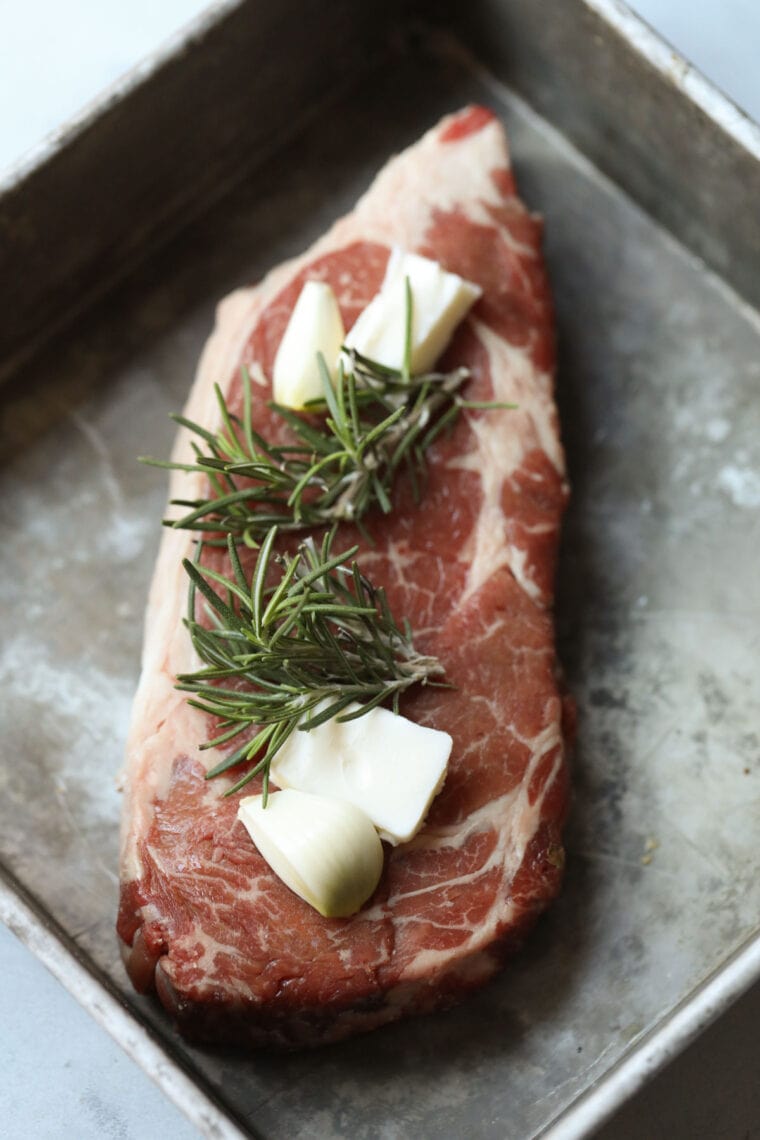
This oven method mimicks what a steak house will do. They will let a steak sit for 15-20 minutes by the stove before cooking it. The difference being that in an industrial kitchen, it is much hotter than your room temperature house.
A low setting (200 degrees F. or lower) oven approximates this setting.
I used a thermometer to make sure my steak didn’t over-cook, but you don’t have to be this finicky.
I’d recommend placing the steak in the oven for around 15 minutes and flipping it once after about 10 minutes. Don’t forget about it as it will start to shoot up in temperature. For a medium-rare steak, you definitely don’t want to let it get above 100˚F in the oven.
When you pull your steak out, you will notice immediately that it is much more tender. It’s almost like your steak has had a few cocktails. It’s just having a good time.
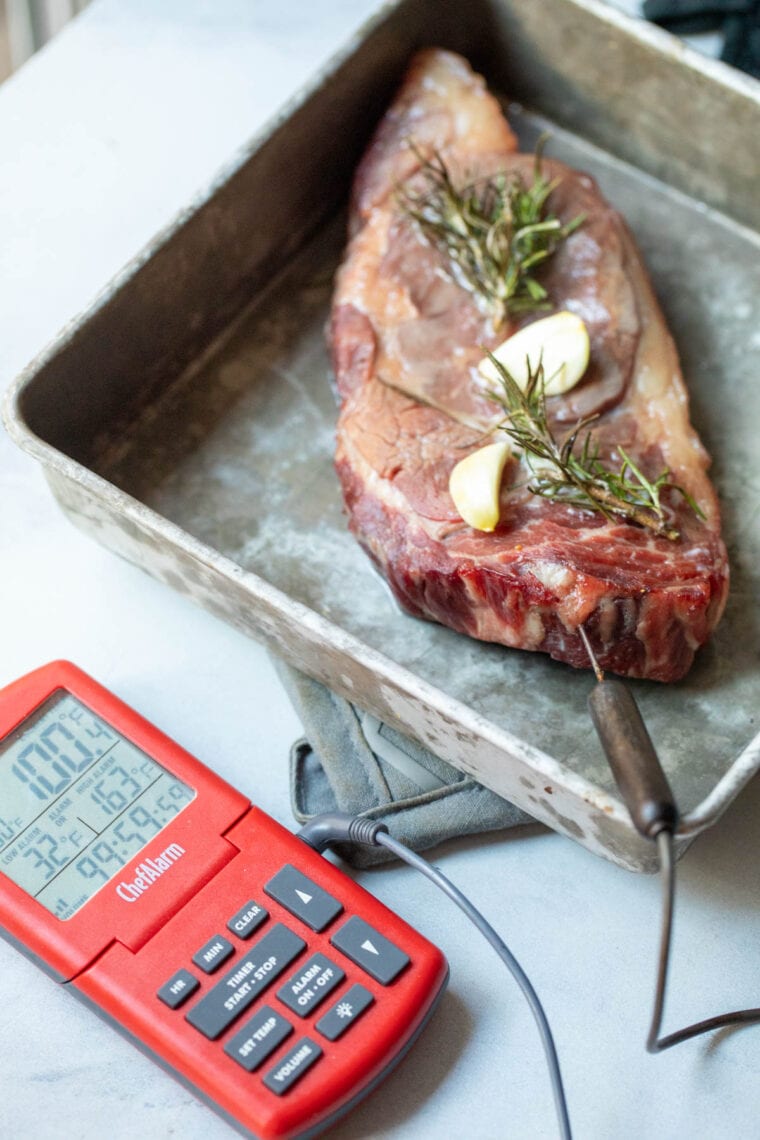
Compare the below photo to the one above to see how just a few minutes in a low heat oven (like 200 or under) can really start to melt those veins of fat.
How to season a steak
The next step is to season this guy. I’m a complete purist when it comes to this. If you have a quality cut of meat, all it needs is salt and pepper. Feel free to give it a liberal amount of both, but I have no desire to put anything else on it.
You can season your steak pretty aggressively as some will fall off in the skillet.
Finishing your steak in a hot skillet
Your steak is now seasoned and relaxed. It’s time to do our best to give it that characteristic steakhouse char on the outside. The way to do this is blazing heat. If you don’t have an industrial-strength salamander (who does?), there is no better way to do this than a cast iron skillet.
Put it over high heat with a tablespoon of high-heat oil (like avocado oil or canola oil) and let it get almost smoking hot over medium-high heat.
Then toss in your steak. If you are cooking more than one, be sure not to crowd them. If you crowd them then the heat will not transfer well and you will end up with a strange gray hunk of meat.
Once your steak is in the pan, don’t touch it. Seriously don’t touch it. It will smoke and steam and hiss and be generally unhappy about the situation. That’s fine. Just let it complain, but don’t touch it!
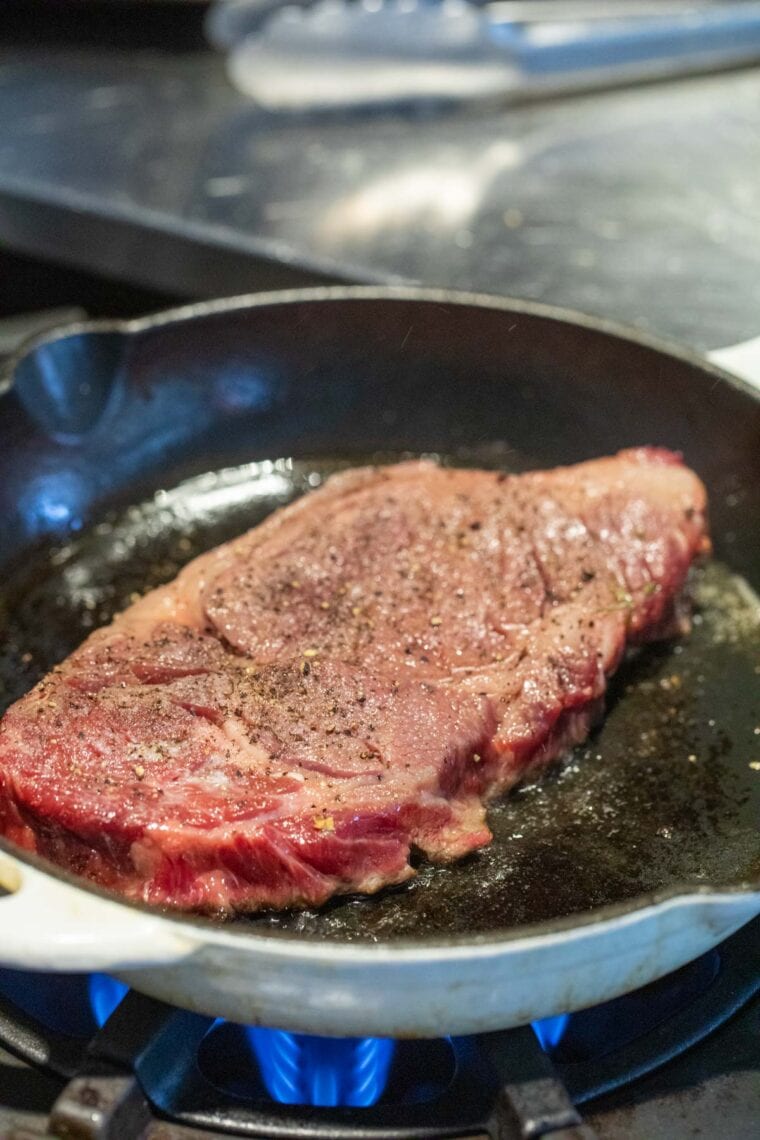
When to turn it is when experience comes in a bit. For a perfect medium rare steak that is a bit under 1 inch thick (like mine in this post), I do about 4 minutes on the first side. When in doubt, I always shoot low as I despise overcooked steak.
When I flip my steak, I like to add some butter to the skillet along with the rosemary and garlic from before and baste the steak as it sears for a few minutes. Note that if you add this butter and herbs right at the beginning they will just burn.
Another 2-3 minutes on the second side and your steak should be ready to go.
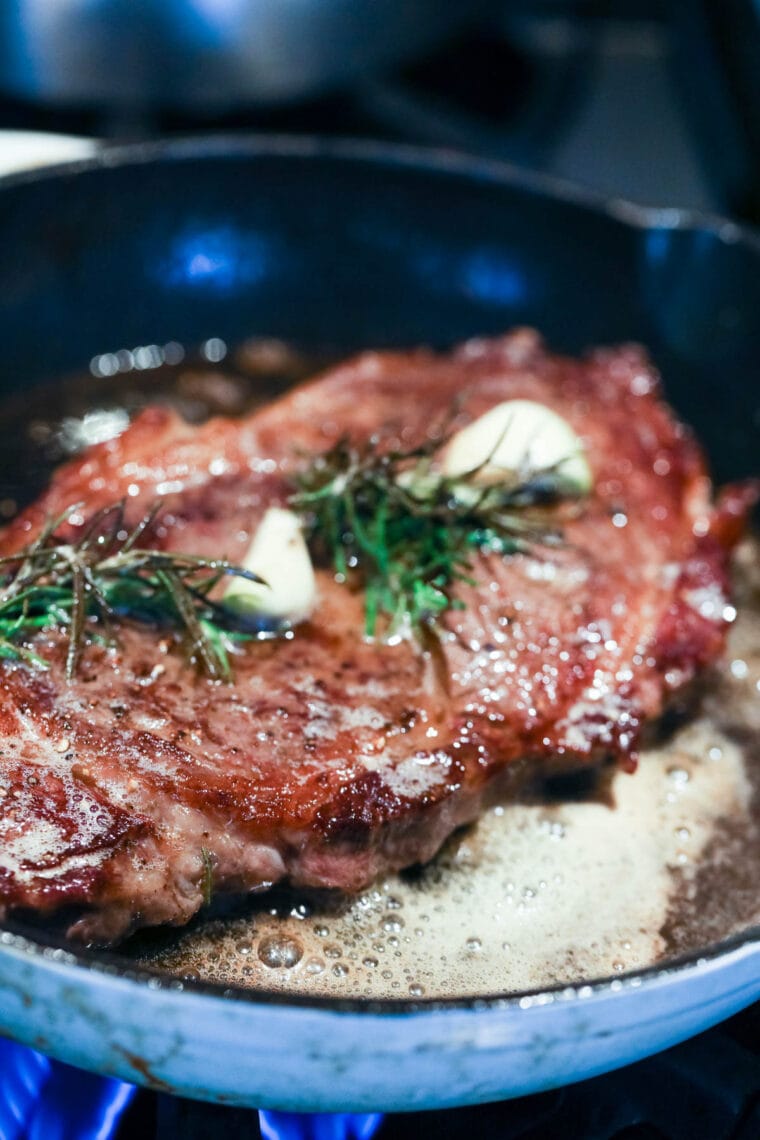
How to tell when your steak is done
The best answer for this is to use an instant read thermometer. For medium rare you’ll want to pull the steak around 130-135˚F and let it start to rest. For medium, shoot for 140-145˚F.
If you don’t have an instant read thermometer, just know that the timing I listed in the post will get you pretty close to medium rare assuming you have a steak around 3/4-inch thick.
You can also use the touch test, which is far from scientific, but does work.
By touching the steak, you can tell a general level of doneness.
If you push your thumb and your fingers together lightly, the section of muscle right below the thumb feels almost identical to a steak at different levels of doneness.
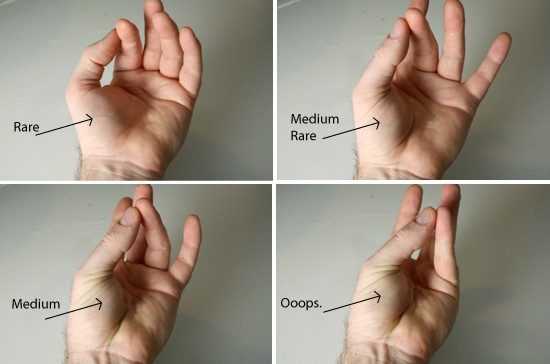
This is because as it cooks, the proteins in the meat tighten and the fat melts away. If you poke a well done steak it will feel like a flexed bicep.
Resting the steak
After you pull this off the heat, let it rest for five minutes before slicing and serving it. This will let the juices redistribute through the meat.
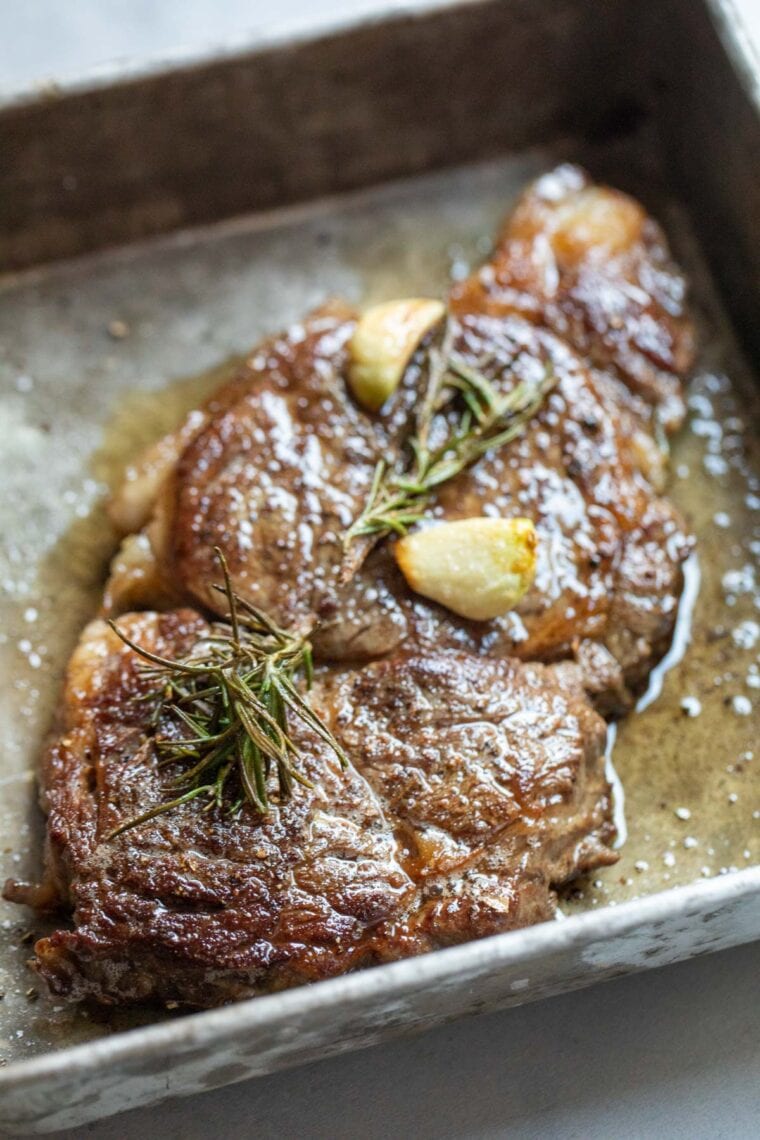
Then serve it up! You can serve it with a variety of side dishes like Crispy Rosemary Potatoes or a good Kale Salad.
Like I said at the beginning of this post, there are a lot of ways to cook steak. This is one of them that I think is very accessible to most people and results in a perfectly cooked steak time and time again.
 Leftovers
Leftovers
Leftover steak is rare at the Crunch Time Kitchen house, but if you do have some leftover steak it’s great cold on sandwiches or salads (like this steak salad) or you can reheat it in a skillet with a little oil. I don’t love microwaved steak, but you can do it in a pinch.
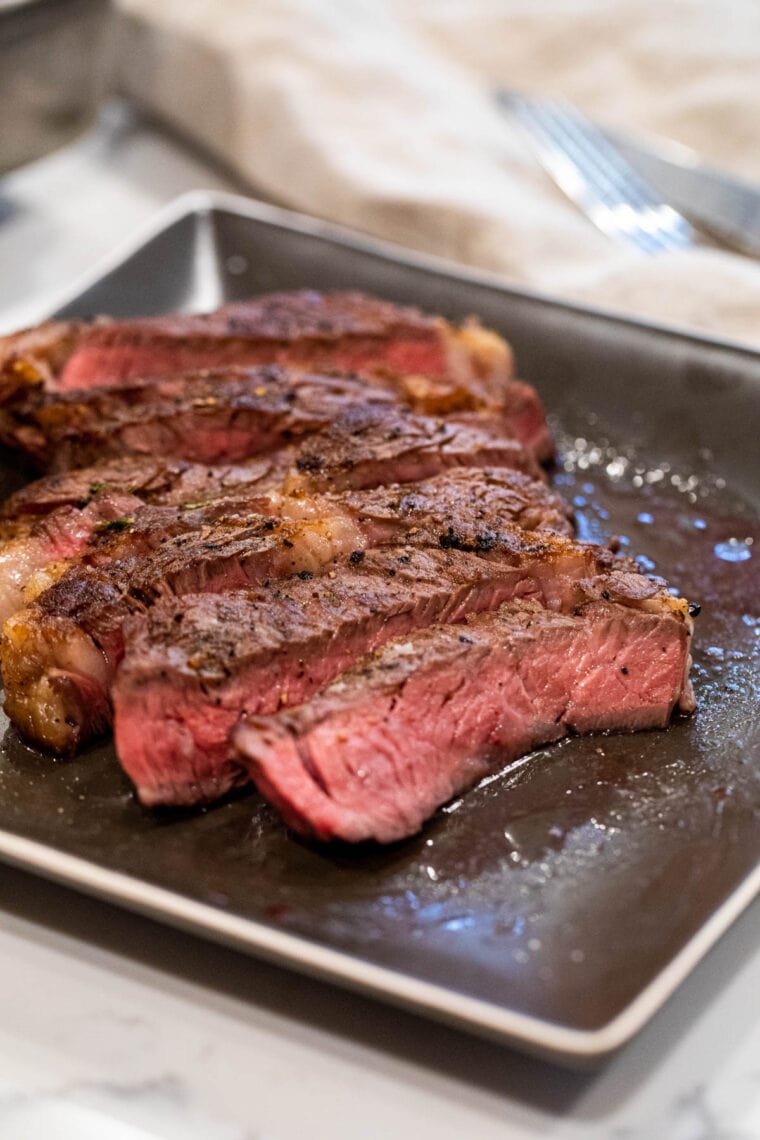
Perfect Steak (Oven Method)
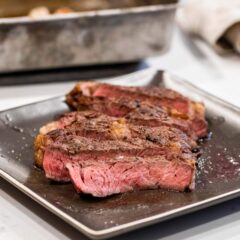
Equipment
Ingredients
- 1 1-pound steak, rib-eye or similar, at least 3/4-inch thick
- 2 tablespoons butter, divided
- 1 clove garlic, crushed (optional)
- 1 sprig fresh rosemary, (optional)
- 1 tablespoon high-heat oil, like canola or avocado
- Salt and pepper
Instructions
- Preheat oven to 200˚F. Place steak in an oven-safe dish and top with 1 tablespoon of butter, crushed garlic, and rosemary (optional).
- Place steak in oven and let come up to temperature for 8-9 minutes. Then flip the steak and return to oven for 4-5 minutes. If you happen to have a thermometer it should register around 90-100˚F.
- Preheat a sturdy skillet over medium-high heat and add a tablespoon of neutral oil.
- Season steak with salt and pepper well on both sides.
- Once the oil is hot, add steak and sear on the first side for 3-4 minutes. Let it cook undisturbed to get a good sear on it.
- Flip the steak and add another tablespoon of butter, plus the rosemary and garlic and as the butter melts, baste the steak for 3-4 minutes or until it hits an internal temperature of around 135˚F. (for medium rare).
- Remove steak and let rest for 5 minutes. Slice into serving slices and pour melted butter and juices from skillet over the steak.
- Serve immediately.

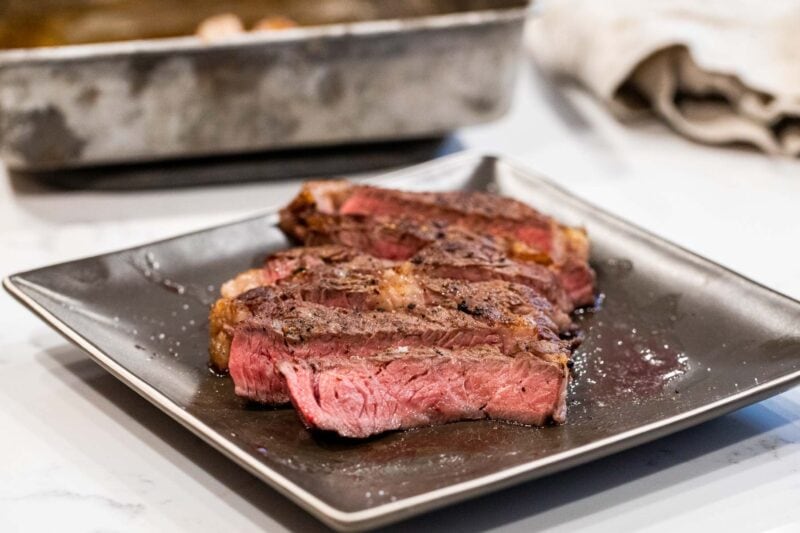
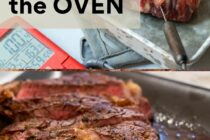
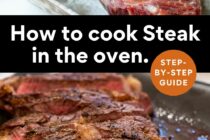
Jean Gogolin
mmmm, looks perfect. I didn't know the relax-in-the-oven trick – thanks! I have a cast-iron pan with ridges that I like very much for steak, and I pour a little bit of good bourbon over the steak right at the end, which makes it sizzle and taste fabulous.
Alex
'I’m a complete purist when it comes to this. If you have a quality cut of meat, all it needs is salt and pepper.' Totally agree. Looks excellent.
Julia Mason
Nick, you are a home chef of the highest quality. My hubby cooks the steak in a different way that produces a steak that is melt in your mouth tender. He lays the steak on the cook top while the oven is heating up. Then he uses a 10 inch cast iron skillet with a little olive oil, once it is smoking hot he places the steak in itand immedialtely turns the heat under it down to about the 5 setting on the knob. Cooks it for about 4 minutes on each side for slightly medium rare for me, and he likes it more rare than I do.
phil
great post… i have a charcoal grill, but when I'm cooking for myself, I don't have the time. And I've got the iron skillet. Now I know what to do.
Speaking of 'high heat' in restaurants: a while back, I was trying to sear tuna and I couldn't get the stove top anywhere near hot enough, so I had the idea to dump half a bag of charcoal in the weber, and then rested the iron skillet way down deep in the coals. Even though I am probably not the first person to try this, I would like to think I am the first person to refer to it as "vulcan-frying" a tuna steak.
(To test if the skillet was hot, I dribbled a little beer into the skillet. The liquid pulled itself into a little ball and bounced around the skillet, looking like mercury. Not sure why that happens.)
Anyway the tuna turned out good. It was smoky as hell when we put the steak on, but it didn't stick like I was afraid it would. To maneuver the tuna around, I needed an oven mitt, a really long spatula (like 24"), and tinted goggles (kidding about the tinted goggles). <1minute per side, and it came off looking like restaurant quality… raw on the inside with a ring of spicy goodness all the way around.
nick
Judging from the marbling on that steak (prime) and knowing your geographical location, I surmise that somebody's been shopping at Wagshals. :-)
This is the ONLY way to cook a quality piece of meat like you got your hands on there above – I posted the method with some similarly ridiculous prime bone-in rib steaks we got from there last month – all excellent info to share with the cooking public at large.
nick
I forgot to mention,
If you are really looking for blisteringly high heat, try grape seed oil which smokes at about 450F, whereas butter does at a more modest 350F (clarified butter would be good here too, but it's expensive and/or a pain in the arse for the casual home cook). It will help with the quality of the sear and lessen the chances of sending the smoke alarms off inside the kitchen.
Here is a link to the smoke point of various fats on wikipedia:
Smoke Points
Nick
Wow! Excellent tips and additions everyone. Thanks for adding to the conversation.
And yea Nick. I got the steak in this post from Wagshals. Nice call. :)
jimmy
I agree on all of your points, though using the oven to warm the steak was a new one to me, I will have to try it.
Thanks, and great site. Just found it via TFIMB.
-Jimmy
Healthy Delicious- L
I LOVE that tip to see how done it is. I'll have to remember that!
Anita
i love the "oops" on the well-done picture of how to check for done-ness. i like my steak med-rare, and had to giggle when i read oops cuz well-done steak is as bad as burnt toast.
my bf likes well-done, so he will be cooking his own steak.
James Garcia
the best smoke alarms are the ones that use photoelectric sensors;.'
Double Bedding
i would prefer to use those cheap ionization type smoke alarms on our home building`*'
NLP Techniques &
smoke alarms are always great investment if you want to avoid having your home burned to the ground “
China Wholesale Electronics Products
Woah! I’m really enjoying the template/theme of this blog. It’s simple, yet effective. A lot of times it’s challenging to get that “perfect balance” between user friendliness and visual appearance. I must say you’ve done a very good job with this. Also, the blog loads very fast for me on Internet explorer. Exceptional Blog!
hp mini 210 review
I loved Spiderman but I just love Sam Rami so Im biased but I just thought Id say that the Watchmen was the biggest waste of three hours in my whole life. Its was really really really bad. I dont care what Ebert said, it sucked balls and a half.
Caernon Jenkins
Quote: “They let it age (which can be reproduced at home, but that is a separate post)”
Any chance you’d feel like doing that post on aging steaks at home, one of these days? You have a knack for laying out such projects in a way that’s both inspiring and comprehensive, and easy to follow as well. <3
(If you've done it already, I apologize, please ignore this. I tried the search, came up with no results, but may have just picked the keywords poorly. ;))
Thanks in advance!
Nick
Heya! You are correct… that post has never happened. The real problem with doing it at home is having a consistently cool and humid environment. I haven’t really had the ambition yet to get a second fridge and rig it for humidity/temp controls. That is on my lifetime to-do list though.
There are some shortcuts out there that seem to work although I’ve never personally tried them. There’s a whole very long chowhound convo on the subject actually.
http://chowhound.chow.com/topics/380223
If you try something out and get good results, let me know. I’ll do the same. :)
Dan
http://www.channel4.com/programmes/how-to-cook-like-heston/articles/all/hestons-perfect-steak-recipe
Try the fast flip method instead.
Beth @ Hooked on Health
I used to work in the industry and had different points on the hand to demonstrate the different levels of doneness but yours is so much easier to remember. I know cast iron (I’m a huge fan) makes a great steak but know I know how to do it. Thanks for the post!
bill
Slow and low? ? ? ? Um this is high and quick. Like grilling but in the pan. In no way is the title correct.
Nick
Hey Bill, you start the steak low and slow in a very low temp oven to bring it slowly up to temperature. Then you sear it quickly at the end to create a crust. Hope that makes sense! Good luck!
Chris
Another thing when resting a steak, you want to do it on a wire rack. The more surface area in contact with the steak, the more those juices are going to want to seep out. The wider the grouping of wires the better.
Nick Preston
Hi Nick – got a question… There are people who reverse sear and forward sear. (i.e. as long as it gets seared its ok!) Can I just sear at start, then put it on oven at 55C (yes my oven goes that low!), and wait until it hits temperature….i.e. why use higher temperatures?